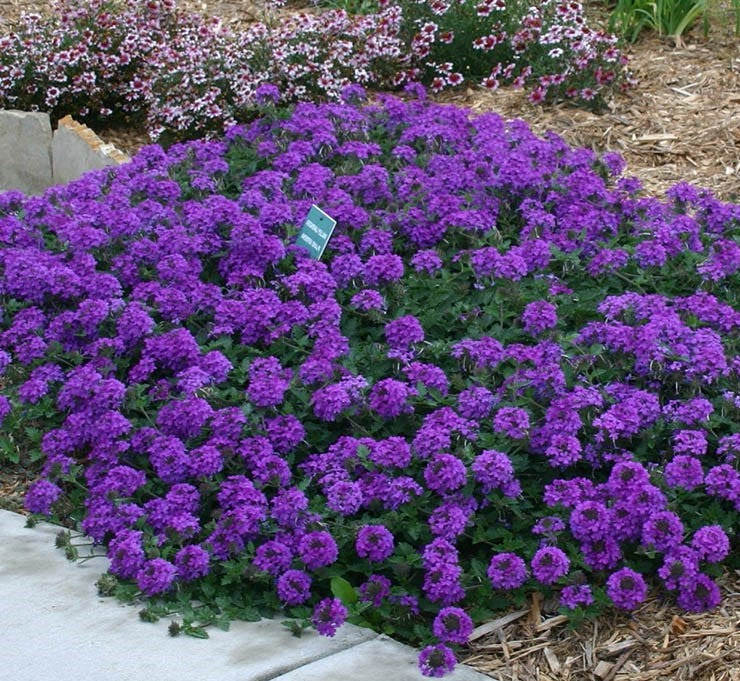by Ken Lain, the mountain gardener
Gorgeous purple flowers cover this summer-long bloomer held over compact green foliage. This bloomer loves bright gardens, summer heat, and grows best in poor soils with less water. The perfect native perennial for summer-long performance.

Botanical Name – Verbenaceae
Common Name – Verbena, vervain, herb of the cross, holy wort
Plant Type – Both annuals and perennials
Mature Size – Varies from six inches tall to six feet tall
Sun Exposure – Full sun
Soil Type – Well-draining, tolerates most soil types
Soil pH – Acidic
Bloom Time – Summer, fall
Flower Color – White, pink, red, lavender, blue, and purple
Hardiness Zones – 5-11
Native Area – Americas and Asia
How to Grow Verbena Plants
Because there are many types of plants in the Verbena genus, gardeners may be confused about which are perennial and annual. Size can vary significantly between varieties, ranging from six-inch ground covers to six-foot plants. No matter the species, plant this robust specimen in a place where it will get 8 to 10 hours of sun each day. Verbena is not particular about soil, except that it must be well-draining.
Light
Verbenas demand a full sun location. Plants growing in low light areas will bloom poorly and be susceptible to powdery mildew and insect pests.
Soil
After choosing a sunny area of your landscape, make sure your soil has adequate drainage. It’s important to add lots of Watters Premium Mulch with the native soil to prevent root rot.
Water
Keep plants evenly moist until established. Verbena is drought tolerant, and it certainly does not do well in boggy conditions, but you must not underwater it either. Soggy plants will succumb to botrytis blight, but drought-stressed plants will attract spider mites. Irrigate Verbena as you might your lawn, with an inch of rain or irrigation each week.
Fertilizer
Fertilize Verbena twice per month with Watters Flower Power when in bloom.
Pruning
All verbenas benefit significantly from regular deadheading. This not only removes the seed heads that signal the plant to rest but also helps to keep sprawling plants in their place in your landscape. For low growing Verbena accomplish this quickly with a string trimmer.
Common Pests
Summer insects like spider mites, mealybugs, and whiteflies can sometimes be found on Verbena. Spray with Watters Triple Action at the first sign on insect damage.
Landscaping
Use trailing varieties in hanging baskets, containers, and at the edge of flower borders. Companion flowers like million bells, pentas, and marigolds all look good together and take the same water and food requirements. All types of Verbena are welcome in the butterfly garden.
Verbena is both a deer and rabbit resistant plant, so take advantage of this by planting it at the edge of your property where animals frequently browse.
Varieties of Verbena Plants
The perennial type, Verbena canadensis, tend to fade away after a few seasons. Brazilian Verbena (Verbena bonariensis) may self-sow freely.
Verbena plants are available in a variety of heights and a range of colors that cover the pink, red, and purple spectrum. All of the plants bear clusters of shallow flowers that butterflies find irresistible. Many plants have lacy or needle-like foliage. Verbena plants have a rich history in herbal medicine. They are still used as a remedy for digestive ills and insomnia.
Blue Vervain: The native Verbena hastata has a tall, airy habit with bluish-purple flowers.
Bonariensis: The popular Brazilian species grows up to six feet tall and self-seeds freely. Grown as a perennial in zones 8 and warmer, it attracts butterflies in droves. Also, try the compact varietals for Bonariensis verbena: “Lollipop” and “Meteor Shower.”
Greystone Daphne – This plant has fragrant lilac-colored flowers on trailing plants.
Homestead Purple – Popular in the garden world, this is a purple-flowering ground cover that performs throughout the growing season. It is a short-lived perennial in zones 6 and warmer.
Lanai Royal Purple with Eye – This plant is bright purple with a contrasting white eye.
Tapien series – Fine, needle-like foliage is the hallmark of this moss verbena.

